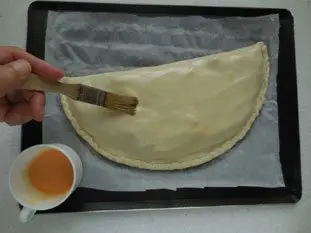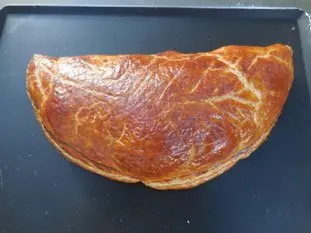This site uses only a few technical cookies necessary for its operation. By continuing to browse, you accept their use.
To find out more...
To find out more...
The golden-brown finish on puff pastry

Let's take a look at the tricky matter of producing puff pastry with an attractive, golden-brown finish. French pastry chefs call this "dorure" (literally, "gilding").
Behind this quirky term there lurks a real problem (and the solution): when using puff pastry (pâte feuilletée) for a pie, or to prepare a feuilletage for a recipe, how can we ensure that the baked pastry has a beautifully browned crust?
Behind this quirky term there lurks a real problem (and the solution): when using puff pastry (pâte feuilletée) for a pie, or to prepare a feuilletage for a recipe, how can we ensure that the baked pastry has a beautifully browned crust?
Last modified on: February 8th 2018
The golden-brown finish on puff pastry
Is this really a problem? Well, yes, as there is no sugar in the pastry – it is just flour, water and butter – so it does not naturally brown well during baking. We need to understand that, even if it is fully cooked, pale and colourless pastry looks pretty unappetising.
To overcome this, pastry chefs/bakers/cooks use a glaze made from beaten egg. They brush the pastry with this before baking.
During cooking, this glaze turns golden brown – the attractive colour that makes puff pastry items so appealing: vol-au-vent, rolls, pasties, etc.
It is very easy to glaze a piece of pastry with a brush, but it is also easy to make the mistake which can ruin everything: glazing down the cut edges of the pastry as well. This prevents the pastry rising, as it effectively "welds" the edges shut and stops the pastry puffing up into flaky layers.
Simply put, we should only brush the glaze over the top surface of puff pastry, and avoid getting on the sides. This will allow the pastry to puff up as much as possible.
This diagram represents a piece of puff pastry on a baking sheet: brown indicates where to brush the glaze, and red indicates where to avoid glazing (yes, I know, I know – you can see that my drawing skills are somewhat limited).
This is why on a vol-au-vent, for example, the top is always nicely browned, but the sides are still pale – and that is just how it needs to be.
To sum up: For nicely browned puff pastry, brush the glaze over the top, but avoid glazing the sides.

To overcome this, pastry chefs/bakers/cooks use a glaze made from beaten egg. They brush the pastry with this before baking.

During cooking, this glaze turns golden brown – the attractive colour that makes puff pastry items so appealing: vol-au-vent, rolls, pasties, etc.

It is very easy to glaze a piece of pastry with a brush, but it is also easy to make the mistake which can ruin everything: glazing down the cut edges of the pastry as well. This prevents the pastry rising, as it effectively "welds" the edges shut and stops the pastry puffing up into flaky layers.
Simply put, we should only brush the glaze over the top surface of puff pastry, and avoid getting on the sides. This will allow the pastry to puff up as much as possible.

This diagram represents a piece of puff pastry on a baking sheet: brown indicates where to brush the glaze, and red indicates where to avoid glazing (yes, I know, I know – you can see that my drawing skills are somewhat limited).
This is why on a vol-au-vent, for example, the top is always nicely browned, but the sides are still pale – and that is just how it needs to be.
To sum up: For nicely browned puff pastry, brush the glaze over the top, but avoid glazing the sides.
Lasts posts
Butter vs. grease
We often read in a recipe where a pastry is put into a mould that, just before pouring, the mould should be buttered or greased. But what's the difference between these 2 terms?December 1st 20251,2495
Getting out of the fridge early
Very often when you're cooking, you need to take food or preparations out of the fridge, to use them in the recipe in progress. There's nothing tricky about this: you just take them out of the fridge and use them, usually immediately, in the recipe. But is this really a good method?November 24th 20251,2245
Who's making the croissants?
When you look at a bakery from the outside, you naturally think that in the bakery, the bakers make the bread, and in the laboratory, the pastry chefs make the cakes. It's very often like that, with each of these professions having quite different ways of working, but sometimes there's also one...November 23th 20251,110
Oven height
When we put a dish or cake in the oven, we naturally tend to put it on the middle shelf, and that's what we usually do. But in some cases, this position and height can be a little tricky, so let's find out why.October 8th 20253,0475
The importance of sieving
In recipes that use a fine powder (flour, powdered sugar, etc.), you'll often see the advice to sift before using it. To sift is to pass the powder in question through a sieve (a very fine strainer) before incorporating it into your recipe. It's often advice, but is it really useful?September 3rd 20257,7363
Other pages you may also like
Candied fruits: don't get ripped off
Do you like candied fruit? You might like to nibble a handful or add it to a recipe, like a classic fruit cake or delicious Italian specialities like panettone or sicilian epiphany pie.June 21th 201767 K 24.2
Egg yolks and caster sugar
We often come across recipes where we need to mix egg yolks with caster sugar. This would appear to be a very ordinary and simple thing to do but, be warned, these two ingredients can behave oddly together.February 15th 201883 K 24.3
Drawing a pattern in pastry
Often in the kitchen, in pastry-making, or in baking, we need to trace a pattern on a pastry. It's just a question of aesthetics but it has its effect after baking on a galette, pithiviers, pâté en croute (terrine in a pie crust), etc.May 23th 201935 K4.1
Perpetual stock
It's something you have probably have done yourself: cooked or pre-cooked vegetables before adding them to a recipe. This is almost always done the same way: peel the chosen vegetables (carrots, for example), cut them up, boil them in salted water (using a tablespoon or so of coarse salt per litre),...November 22th 201631 K5
A few tips for effective kneading at home
When you have to knead dough for bread or some other recipe, you may well use a food processor or the type of machine known as a stand mixer. The best-known brands are Kenwood and KitchenAid. They are useful tools, but here are a few tips to help you get the best out of them.June 23th 2021284 K 23.8
Follow this page
If you are interested in this page, you can "follow" it, by entering your email address here. You will then receive a notification immediately each time the page is modified or a new comment is added. Please note that you will need to confirm this following.
Note: We'll never share your e-mail address with anyone else.
Alternatively: you can subscribe to the mailing list of cooling-ez.com , you will receive a e-mail for each new recipe published on the site.










The 2 comments already posted on this page